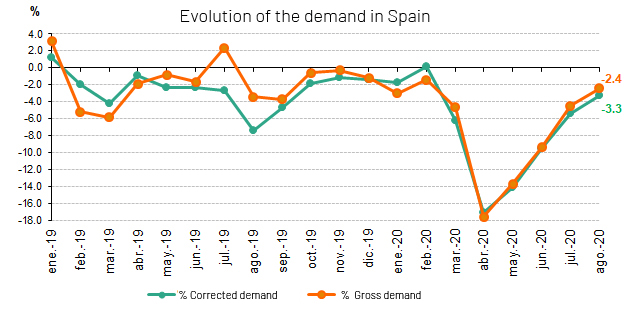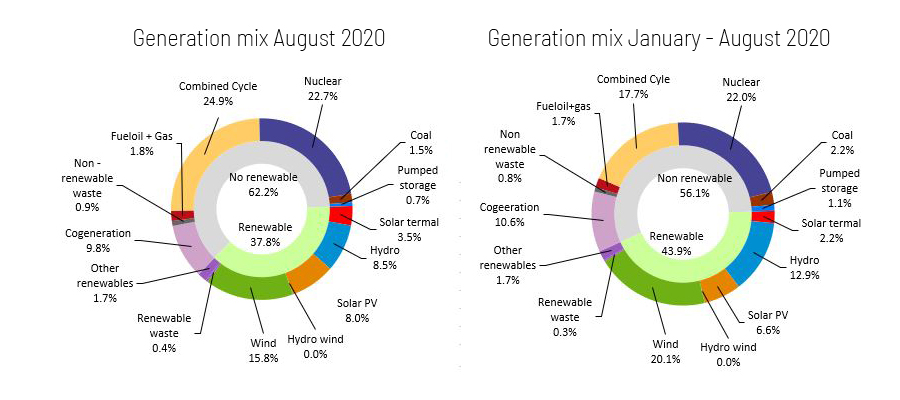For 40 years, we've been driving our country's economic and social progress. Four decades shaping Spain.
Demand for electricity in Spain drops 2.4% in August
- 37.8% of monthly generation came from renewable sources and 61.2% was produced using technologies that do not emit CO2 emissions.
- Demand for electricity in the Balearic Islands and the Canary Islands fell by 19.7% and 8.0% respectively when compared to the same month in 2019.
- Solar photovoltaic continues to increase its share in the production of energy nationwide.
- Cumulative generation, which on 3 August totalled 9,288 GWh for the year, already exceeded that recorded for the whole of 2019. At the close of August, the figure reached 10,932 GWh.
Red Eléctrica de España publishes the electricity demand for August, the second complete month since the end of the state of emergency due to the Covid-19. In this context, the national electricity demand for August is estimated at 22,158 GWh, 2.4% less than that registered in the same month of the previous year. After having factored in the influence of seasonal and working patterns, this figure has fallen 3.3% compared to August 2019.
Compared to the same month in 2019, the decline in August was less significant than that of the last few months and continues to show a gradual recovery in terms of energy consumption. During the period of the state of emergency (from 15 March to 21 June), demand was 13.3% lower in the Spanish electricity system compared to the same period in 2019.

In August, and according to data estimated at the time of this press release, generation coming from renewable energy sources represented 37.8% of the total production. During the first eight months of the year, renewable generation reached 43.9% of the total electricity generated nationwide. 61.2% of electricity generation during August was obtained using technologies which produce zero CO2 emissions.
With information available as at the time of this press release, solar photovoltaic energy in August continued to increase its share in the generation mix nationwide. Cumulative generation, which on 3 August totalled 9,288 GWh for the year, already exceeded that recorded for the whole of 2019. At the close of August, the figure reached 10,932 GWh.
For its part, wind energy generation in August reached 3,593 GWh, 24.3% more than the same period last year, and represented 15.8% of the total national production, making it the third technology in the generation mix after that of combined cycle and nuclear.

Demand for electrical energy in the peninsular electricity system drops 1.7%
Demand for electrical energy in the peninsular electricity system in the month of August is estimated at 20,825 GWh, a value 1.7% lower than that recorded in the same month last year. After having factored in the influence of seasonal and working patterns, the demand for electricity is 2.6% lower than that registered in August 2019.
In the first eight months of 2020, the demand for electricity on the Spanish Peninsula is estimated at 156,625 GWh, a figure that is 6.5% lower than in 2019. In this case, after having factored in the influence of seasonal and working patterns, demand is also 6.7% lower than that registered in the same period last year.
During August and according to data estimated at the time of this press release, 38.8% of the peninsular generation came from renewable energy sources and 63.4% was obtained using technologies which produce zero CO2 emissions. For its part, wind energy stood at 3,421 GWh, a figure that is 25.2% higher than that registered in August last year and contributed 15.9% to the mix.
Demand for electricity in August decreased 19.7% in the Balearic Islands and 8.0% in the Canary Islands
In the Balearic Islands, the demand for electricity in August is estimated at 565,899 MWh, a value that is 19.7% lower than that registered in the same month last year. After having factored in the influence of seasonal and working patterns, the figure decreased by 20.2% with respect to August 2019. In the first eight months of 2020, demand in the Balearic Islands is estimated at 3,368,224 MWh, 20.1% less than in the same period in 2019.
Combined cycle, with 71.5% of the total, was the leading source of electricity generation in the Balearic Islands, where renewable technologies and those which produce cero CO2 emissions, accounted for 6.0% of the generation mix for the month. For the eighth consecutive month, coal did not produce a single MWh in the Balearic electricity system.
In regard to the Canary Islands, electricity demand is estimated at 725,935 MWh, 8.0% down on that registered in the August last year. After having factored in the influence of seasonal and working patterns, the figure falls by 8.4% with respect to the same month last year. Demand in the Canary Islands during the first eight months of the year is estimated at 5,281,989 MWh, a decrease of 10.0% on the same period in 2019.
Combined cycle, with 31.1% of the total, was the leading source of electricity generation in the Canary Islands. Renewable technologies and those which produce cero CO2 emissions accounted for 27.9% of the total generation on the Canary Islands.
Consult our Daily Balance Report for more information on the National, Peninsular, Balearic Islands and Canary Islands electricity systems as at the close of July.












